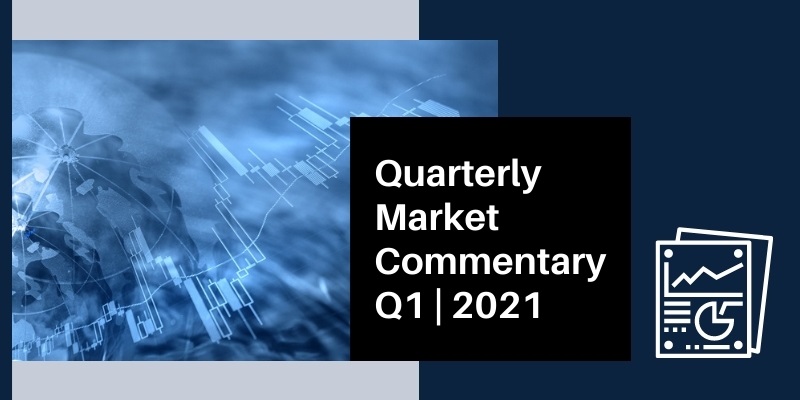
Market Update
2020 was an unforgettable year – largely for all the wrong reasons. COVID-19 impacted every facet of our daily lives and is likely to have a lasting impact on our global economy. Many parts of the economy effectively hit a brick wall earlier in the year, as social distancing policies ground activity to a halt for many businesses. It’s unlikely our economy will fully recover until a vaccine is widely distributed and available to the broader population, which will allow restrictions to be lifted and businesses across all sectors to begin running on all cylinders again. While we hope to reach herd immunity in the second half of 2021, it will take some time to bring unemployment back to pre-COVID levels. At the same time, we anticipate inflation will continue to run below the Fed’s long-term target of 2% for the foreseeable future. With this backdrop, we expect continued accommodative monetary policy and fiscal stimulus to support the economy in the years ahead and despite significant near-term uncertainties, we believe we are in the early stages of a new economic growth cycle.
Stocks Rally
2020 ended up being a strong year for the stock market. The S&P 500 closed the year at a record level, and global stocks returned over 16% (as measured by MSCI ACWI Index). However there was also a lot of dispersion in performance across equities, with growth stocks outperforming value and dividend-focused stocks, particularly in the first half of the year. U.S. stocks outperformed international markets, while many sectors struggled, notably energy, public REITs, and financials, to name just a few.
2020 certainly wasn’t a smooth ride: volatility was elevated throughout the year and we experienced the fastest bear market in history as the economic impact of the coronavirus and related social distancing policies took hold in March. This was followed by trillions of dollars in government aid and unprecedented market support from the Federal Reserve. Had 2020’s headlines been known ahead of time, most people would assume it would be a horrible year for the stock market. The market strength really underscores the importance of maintaining investment discipline in the face of market uncertainties, not overreacting to dire headlines but rather rebalancing systematically and sticking to a long-term financial plan and diversified asset allocation. In March and April of 2020 we were broadly adding to stock exposures and tax-loss harvesting across many client accounts, which in turn helped overall portfolio performance as the stock market rallied through the remainder of the year.
Bonds Anchor Portfolios
Core bonds held steady through the market volatility and helped to anchor portfolios at the height of the crisis. Yields fell, with the benchmark 10-year U.S. Treasury yield ending the year at 0.92%, down from 1.92% at the start of the year. As such, the broad US bond market returned 7.5% for the year (as measured by the Bloomberg Barclays Aggregate Bond Index), while high quality municipal bonds returned 5.1%. The relative strength in bonds, particularly at the height of the crisis, provided us with rebalancing opportunities: in following our disciplined approach we were broadly selling core bonds on strength to buy equities on weakness.
Politics in Focus
Recent market attention has turned to the outcome of the two special election runoffs in Georgia. With Democrats Raphael Warnock and John Ossoff winning both runoffs, Democrats now take a slim majority control in the Senate, along with control of the White House and the House of Representatives. Under a unified White House and Congress, the risks surrounding increased taxes and potential regulatory reform are elevated. However, meaningful changes seem unlikely – at least over the near-term – as many politicians may be hesitant to risk derailing the nascent economic recovery given the lingering economic headwinds from the coronavirus pandemic. Moreover, Democrats control the Senate with a razor thin margin and we anticipate potential pushback from centrists, particularly in light of the narrowed majority in the House. On the other hand, Democratic control is seen as a positive for more coronavirus relief and infrastructure stimulus. This outlook has been borne out in the Treasury market, where the 10-year Treasury is now trading above 1% for the first time since last March, reflecting an increase in the reflation narrative.
Elsewhere in politics and as expected, Congress ratified President-elect Joe Biden as the election winner despite the process being interrupted due to the Capitol building riots.
Outlook
We continue to remain disciplined and focused on long-term fundamentals. Despite significant uncertainties still surrounding the economy and financial markets, we do believe we are in the very early stages of a new economic expansion and longer term growth potential exists. With this backdrop, volatility may stay elevated for some time, but any short-term market weakness may provide us with additional rebalancing opportunities. We expect 2021 to be a positive year for global markets and we continue to maintain balanced exposure across all major asset classes including areas of the market that have been out of favor and may be trading at more attractive valuations. Generating strong income across core bonds in a low interest rate environment will remain challenging, so we continue to source yield across institutional income based strategies. We believe our diversified portfolios are well designed to navigate both the near-term market environment, and ultimately achieve the long-term financial goals of our clients.
00390786 01/21

